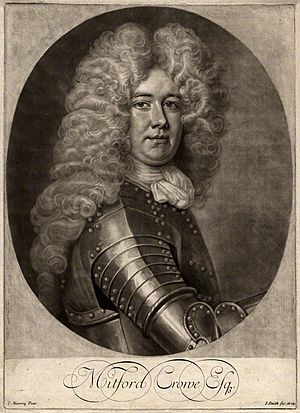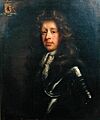Mitford Crowe facts for kids
Quick facts for kids
Mitford Crowe
|
|
|---|---|
 |
|
| Governor of Barbados | |
| In office 1707–1710 |
|
| Monarch | Queen Anne |
| Preceded by | Sir Bevil Granville |
| Succeeded by | George Lillington |
| Member of Parliament for Southampton |
|
| In office 1701–1702 |
|
| Preceded by | Roger Mompesson John Smith |
| Succeeded by | Frederick Tylney Adam de Cardonnel |
| Personal details | |
| Born | 18 April 1669 Hexham, Northumberland |
| Died | 15 December 1719 (aged 50) England, Great Britain |
| Spouse | Urania Sandiford (m. 1697) |
| Profession | Diplomat, merchant, politician, colonial administrator |
Mitford Crowe (born April 18, 1669 – died December 15, 1719) was an important English figure. He worked as a diplomat, a merchant, and a politician. He also served as the governor of Barbados from 1707 to 1710.
Crowe is best known for his work during the War of the Spanish Succession. He helped create the Pact of Genoa. This agreement brought Catalonia into an alliance with England.
Contents
Who Was Mitford Crowe?
Mitford Crowe was born in April 1669 in Hexham, Northumberland, England. When he was young, he moved to Barbados. There, he learned about trade by working for a merchant. Later, he moved to Barcelona before 1697.
Around 1700, Crowe moved to London. He continued working as a merchant. He also became a colonial agent for Barbados. This meant he represented Barbados in England.
Starting a Political Career
In England, Mitford Crowe began his political journey. He was elected to the House of Commons in February 1701. He served as a Member of Parliament until July 1702.
In 1702, King William III chose Crowe to be the governor of Barbados. However, the king died soon after. This meant Crowe's appointment was cancelled.
Crowe's Diplomatic Missions
In 1705, Mitford Crowe was sent to Catalonia. His job was to gain support for Archduke Charles. Archduke Charles was a candidate for the Spanish throne. This was during the War of the Spanish Succession. This war was fought between two main groups. One group supported the Habsburg family, and the other supported the Bourbon family.
Crowe worked to connect with Spaniards who supported the Habsburgs. These people were called "Austracists." It was hard to make a deal because the Spanish ruler in Catalonia was against them.
The Pact of Genoa
On May 17, 1705, Crowe signed an important agreement. It was called the "Pact of Genoa." He signed it with a group of Austracist leaders. This agreement was a military alliance between England and Catalonia.
The pact said that England would send 10,000 soldiers to Catalonia. England would also provide military supplies. In return, the Catalans would recognize Archduke Charles as the King of Spain. This agreement was kept secret at first.
Working with the Military
After signing the pact, Crowe went to Genoa. He continued his diplomatic work there. Meanwhile, a Royal Navy fleet sailed to Catalonia. It carried a large English army. Their goal was to attack Barcelona.
Crowe stayed in touch with the fleet's leader, Sir Cloudesley Shovell. Crowe sent reports saying the Catalans were ready to rebel. The English forces eventually captured Barcelona in October 1705. After the city was taken, Crowe joined the English military leaders. He advised them on future plans in Catalonia.
Governor of Barbados
In October 1706, Mitford Crowe was chosen as the governor of Barbados. He arrived there on May 8, 1707. When he got there, Crowe said the government was full of problems. He claimed it was "nothing but corruption."
As governor, Crowe made many changes. He worked to improve the island's defenses. He also removed several members of the government council. He focused on working with the House of Assembly. He tried to reduce the power of a small group of lawyers.
Challenges as Governor
Crowe's actions made him very unpopular with the powerful people in Barbados. They said he was unfair and acted like a dictator. They also accused him of taking bribes. Some even complained that he hired a Catholic servant. This was a big deal at the time because most people in Barbados were Protestant.
In 1708, the government in England warned Crowe about his behavior. In 1709, Queen Anne herself sent him a letter. She was angry that he had not followed her orders. Crowe reacted by yelling at those who complained about him.
Recalled to England
Crowe was temporarily called back from Barbados in October 1709. He left the island on May 15, 1710. When he arrived in England, he had to explain his actions. He appeared before the Privy Council.
The Privy Council looked into the complaints against Crowe. They decided that the complaints were "frivolous," meaning they were not serious. They dismissed the charges against him. However, Crowe was not sent back to Barbados as governor.
Later Life and Legacy
After the hearing, Mitford Crowe mostly stopped working in public life. He became friends with people like the writer Jonathan Swift. Swift's letters often mentioned Crowe.
Mitford Crowe died in England on December 15, 1719. His wife, who was living in Barbados, handled his will.
Family and Connections
Crowe's political life was influenced by his family. His brother, Christopher, married Lady Charlotte Lee. She was the daughter of an important earl. Crowe also had a good relationship with Thomas Fairfax, 5th Lord Fairfax of Cameron. Lord Fairfax chose Crowe to help manage a special license. This license gave Lord Fairfax the right to find shipwrecks in the West Indies.
On December 15, 1698, Crowe married Lady Urania Chamberlain. She was a widow who owned a plantation in Barbados. They had three sons: George, Mitford, and William. All three were baptized in London.
Military Rank
During his time in Spain and Barbados, Crowe was known as a colonel. However, it's not clear which military he belonged to. He might have been part of the Barbados Militia. White Barbadians often became officers in this militia.
Dealing with Indigenous Peoples
Crowe also changed how the English dealt with the Caribs. In 1707, he convinced seven Carib chiefs from St. Vincent to sign a treaty. He did this by giving them gifts. This was different from past English leaders. They often tried to force their will on the indigenous Caribbeans.
Images for kids
-
A 1684 portrait of Thomas Fairfax, 5th Lord Fairfax of Cameron by John Riley
See also
 In Spanish: Mitford Crowe para niños
In Spanish: Mitford Crowe para niños


